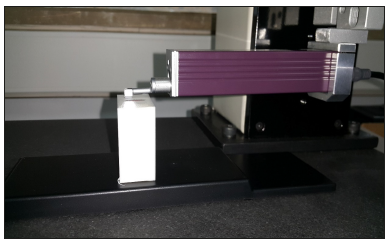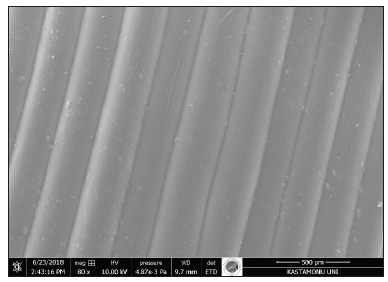- Submissions

Full Text
Evolutions in Mechanical Engineering
Examination of the Effect of Surface Roughness of Parts Produced in the Different Nozzle Temperatures on 3d Printers
Fuat Kartal*
Mechanical Engineering Department, Turkey
*Corresponding author:Fuat Kartal, Faculty of Engineering and Architecture, Mechanical Engineering Department, Turkey
Submission: April 1, 2019; Published: April 26, 2019

ISSN 2640-9690 Volume2 Issue4
Abstract
In the present study, the surface roughness values of the models produced by different open nozzle temperatures by an open source three-dimensional printer were examined and the effect of the temperature parameter on the surface roughness was investigated. All models are produced by adding solid material. A low-cost open source coded 3D printer was used to produce these materials. Polylactic acid (PLA) was used as the main polymer material for printing. The nozzle with temperatures of 180 °C, 190 °C, 200 °C, 210 °C, 220 °C, and 230 °C was tested whether 3D printed models are effective in roughness. In this study, where the surface roughness was measured as the average (Ra-μm), it was found that the surface roughness value showed a decreasing trend with increasing temperature.
Keywords: Fused deposition modeling; Additive manufacturing; Layered manufacturing
Introduction
Fused Deposition Modeling (FDM) is fast-growing Rapid Prototyping (RP) technology due to its ability to produce functional parts with complex geometric shapes [1-3]. Reduced product development cycle times are a major concern for maintaining competitive strength in the industrial market. For this reason, rapid production techniques such as RP have been adopted from the traditional product development methodology [1,2]. In the manufacturing phase, the process parameters can be adjusted appropriately to improve the properties. The properties of RP parts can be improved considerably because they are a function of various parameters [2,3]. Since mechanical properties are important for functional parts, it is essential to examine the effect of the various process parameters on these properties and to ensure that such optimization can be done by selecting the best settings [3-5]. The process is carried out by using thermoplastic filaments extruded from the end of the nozzle and providing solidification at room temperature. The properties of the structural parts depend on the settings of the various process parameters fixed during manufacture. It is not difficult to produce products with complex shapes, aesthetically pleasing and articulated production. The challenge is to produce functionally reliable parts [4,5]. Today, the process of producing additives, including the FDM process, needs to satisfy customer needs and satisfaction. It is aimed to carry features such as superior track quality, high efficiency ratio, safety, low production cost and short lead-time [6].
The main success of the additive generation process depends on the correct choice of process parameters. Determining the most appropriate process conditions is an important task for the production engineer [6,7]. Achieving product quality, increasing dimensional accuracy, increasing productivity rates play an important role in reducing production time and cost. FDM is a complex process that is very challenging in determining optimum parameters due to the presence of numerous conflicting parameters that can affect part quality and material properties. The part quality and mechanical properties of the manufactured part can be achieved by correct selection of process parameters [7-10]. In this study, the effect of nozzle temperature on the surface roughness, which is one of the most important process parame- ters in the Fused Deposition Modeling (FDM) using PLA filament, was investigated by an experimental study. This study is a guideline for research and development studies to be carried out in the future in order to enable technology to offer products with better dimensional, mechanical and ergonomic properties.
Material and Method
In this study. Open source Dream Maker 3D printer was used for the production of samples with PLA material, a material commonly used for FDM fragments (Figure 1). The CAD model of the part is prepared in SolidWorks package program. The input extension to the FDM machine for material creation has been converted to “STL” format. The pieces were formed in layers by stacking of PLA melt material having a constant layer thickness of 0.200mm. Table 1 shows the technical capacity of the Dream Maker 3D printer and the constant parameters used in the study.
Figure 1:Open source Dream Maker 3D printers.

Table 1:Technical capacity features of the open source three-dimensional printer.

Findings and Discussion
In this study, printing was done with PLA filament with Dream Maker 3D printer. The plate temperature was set to 50 °C and the nozzle temperature was set to 180 °C, 190 °C, 200 °C, 210 °C, 220 °C, 230 °C and 240 °C respectively to produce 40x40x40mm parts for PLA material printing (Figure 2). The difference in the macro views of the parts is not visible, but there were differences in measurements made on the surface roughness device. Three different measurements were made for each sample of the cubic piece produced using the PLA filament with surface roughness device and the mean values of these measurement results were taken. Surface roughness values from seven samples are given in Table 2. The surface roughness measurement is given in Figure 3.
Figure 2:Image of cube pieces in 40x40x40mm dimensions produced at seven different temperatures.

Figure 3:Surface roughness measurement image of PLA-produced parts.

Table 2:Surface roughness obtained when the nozzle temperature is 180 °C, 190 °C, 200 °C, 210 °C, 220 °C, 230 °C and 240 °C.

According to the surface roughness values given in Table 2, the lowest roughness value was obtained as 9.48μm at 190 °C and the highest roughness value was obtained as 10.72μm at 210 °C. The difference between the lowest roughness value and the highest roughness value was 12%. Before the test, it was estimated that the lowest roughness value could be obtained if the temperature was 240 °C. But the results were surprising after the same three-dimensional printer was run on the same conditions. According to the report and user’s catalog of the e-Sun company, which is a commercial PLA filament producer, it has been emphasized that the nozzle temperature should be 205 °C-225 °C for best performance. As the nozzle temperature is very important in terms of production speed, the printing performance also changes accordingly. In three-dimensional printers, parameters such as surface roughness, processing time, measurement accuracy and cost are used as experimental output. While one of these parameters shows a positive increase, the other parameter values may change in the negative direction. Figure 4 shows how the mean surface roughness values change at nozzle temperatures of 180 °C, 190 °C, 200 °C, 210 °C, 220 °C, 230 °C and 240 °C. The SEM image of the surface obtained by producing the nozzle temperature at 190° is given in Figure 5.
Figure 4:Graphical representation of the surface roughness obtained at nozzle temperatures of 180 °C, 190 °C, 200 °C, 210 °C, 220 °C, 230 °C and 240 °C.

Figure 5:SEM image of produced part at nozzle temperatures of 190 °C..

Conclusion and Recommendations
The use and widespread use of open source printers has been increasing remarkably in our country and in the world. Since the scientific experimental works on this subject are not yet available sufficiently, new mathematical data and models are needed which can be obtained from various predictive and experimental works.
In this study, the findings obtained within the tested limits are listed below;
A. The lowest surface roughness value for PLA filament material with a melting point of 190 °C was obtained as 9.48μm.
B. The highest roughness value at 210 °C was 10.72μm.
C. The nozzle temperature of 220 °C in normal use is between the lowest and highest roughness values.
D. It can be argued that keeping the temperature high considering the environmental conditions, keeping the temperature at 240 °C, will give a better layer structure for a good melting formation.
E. As the temperature increases, the increase of the surface roughness and then the decreasing tendency can be interpreted by investigating the chemical structure of the filament material. This suggests that further studies are needed in terms of chemical stability.
F. Since the selected values are limited in this study, more experimental results and range are required for the graph to show larger data.
G. In case temperature of the nozzle is normally high, it is considered that this situation may cause malfunction of the sensor and the nozzle mechanism.
Acknowledgment
The author would like to thank Kastamonu University Faculty of Engineering Dept. for their material and spiritual support for their laboratory activities.
References
- Karakuş K, Güleç T, Kaymakçı A, Aksu T, Kirit A, et al. (2010) Effect of polymer composites produced by extrusion method on some mechanical Properties Özellik. 3rd National Polymer Science and Technology Congress and Exhibition, Kocaeli, Turkey.
- Tuna B, Özkoç G (2012) Improvement of recycled PLA’s properties by reactive extrusion method: model study. 4th National Polymer Science and Technology Congress, Çanakkale PIR-1, Turkey.
- Gören G, Balaban M, Yılmaz O, Kırkköprü K, Doğu M (2010) Systematic design of spiral channel extrusion mold for plastic pipe production. 3rd National Polymer Science and Technology Congress and Exhibition, Kocaeli, Turkey.
- Koyun, Akdoğan AN (2006) Causes and solutions for wear and fatigue behavior in plastic extrusion screws ve. Electronic Journal of Machine Technologies (3): 65-71.
- Ulutan S, İzmirli GB, Göktepe E (2004) Mechanical and structural properties of pipes produced after recycling from high density polyethylene et. 6th National Chemical Engineering Congress, İzmir, Turkey.
- Oktay K (2015) Double filament lasting extruder design in 3D printers producing melted masonry method erg master thesis. Istanbul Technical University/Institute of Science and Technology, Istanbul, Turkey.
- Sayer S, Özkan E (2007) Similarities and combinations in the production of ceramics and polymers. Lari Science-Technology Magazine 22.
- Yang W, Fortunati E, Dominici F, Kenny JM, Puglia D (2015) Effect of processing conditions and lignin content on thermal, mechanical and degradative behavior of lignin nanoparticles/polylactic (acid) bio nanocomposites prepared by melt extrusion and solvent casting. European Polymer Journal 71: 126-139.
- Namiki M, Ueda M, Todoroki A, Hirano Y, Matsuzaki R (2014) 3D printing of continuous fiber reinforced plastic. Proceedings of the Society of the Advancement of Material and Process Engineering, USA, pp. 1-6.
- Jonoobi M, Harun J, Mathew AP, Oksman K (2010) Mechanical properties of cellulose nanofiber (CNF) reinforced polylactic acid (PLA) prepared by twin screw extrusion. Composites Science and Technology 70(12): 1742-1747.
© 2019 Fuat Kartal. This is an open access article distributed under the terms of the Creative Commons Attribution License , which permits unrestricted use, distribution, and build upon your work non-commercially.
 a Creative Commons Attribution 4.0 International License. Based on a work at www.crimsonpublishers.com.
Best viewed in
a Creative Commons Attribution 4.0 International License. Based on a work at www.crimsonpublishers.com.
Best viewed in 







.jpg)






























 Editorial Board Registrations
Editorial Board Registrations Submit your Article
Submit your Article Refer a Friend
Refer a Friend Advertise With Us
Advertise With Us
.jpg)






.jpg)














.bmp)
.jpg)
.png)
.jpg)










.jpg)






.png)

.png)



.png)






